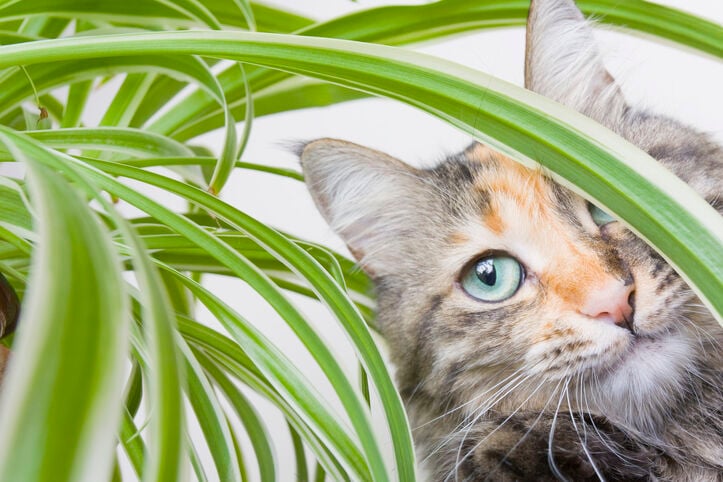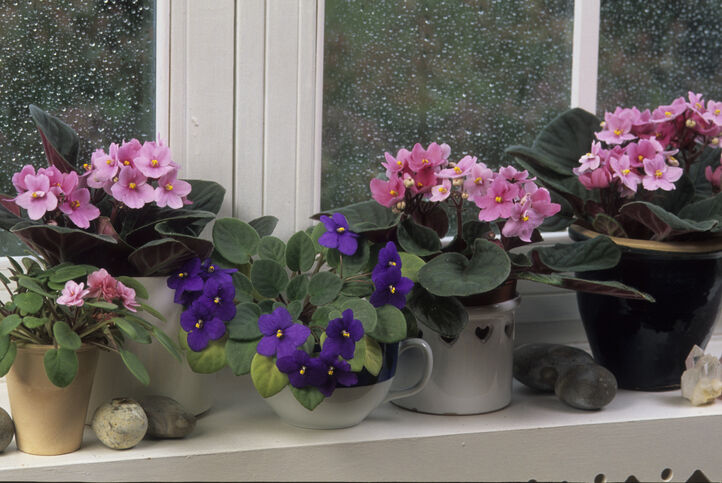In Tucson, we are fortunate to be able to garden outside year round. However, you still might want some plants in the house to cheer up the space and add a little green. Indoor plants help make our homes more appealing. Research has also shown they may have other benefits, like stress reduction, improving indoor air quality and mental and physical healing.
However, many common houseplants are toxic to pets, with whom we share our homes. Some can even be deadly. Fortunately, there are a lot of non-toxic options for pet lovers. Here are a few of the most popular. These should be easy to find in any nursery.
Because most houseplants are originally understory tropical forest plants, they tend to do best with frequent, regular watering, rich acidic soil, indirect sunlight, and moist air. Do not put them in the path of an air vent, and some of the more delicate plants may need to be located in moister rooms of your house, like the bathroom.

Christmas cactus provides winter color as an alternative to poinsettias.
Christmas cactus (Schlumbergera bridgesii): A great alternative to poinsettias, which can be mildly toxic to cats and dogs if eaten. It comes in various shades of red. It’s very easy to propagate by cuttings. Despite the name, it needs moist soil and no direct sunlight to thrive.

Areca palms can grow up to 10 feet tall indoors.
Areca palm (Dypsis lutescens): Areca palms are lush and can be quite tall (up to 10 feet!), bringing a lot of green into your house. They like moist soil, but won’t do well if you over-water them. They’re native to Madagascar and were once endangered.

Calathea plants have distinctive multicolored leaves. They are easy to divide once they've outgrown their pot.
Prayer plant/Calathea (Calathea spp.): These plants have very ornamental leaves, and make popular houseplants. Many of the Calatheas you see are native to Brazil and surrounding tropical areas. They stay fairly small, under a foot tall, but can spread as they mature. They can be divided and re-potted easily as they grow.
Spider plant (Chlorophytum comosum): Perhaps the easiest houseplant to grow, spider plants are pretty tolerant of a variety of environments, but will be particularly lush if you treat them well. Their draping stems and leaves make them ideal for hanging containers.

Money tree plants have unique braided trunks. In their natural habitat they grow to 60 feet.
Money tree (Pachira aquatica): Native to Central and South America, the money tree plant has an interesting braided trunk and deep green leaves. Its natural habitat is swamps, where it grows into a full-sized 60-foot-tall tree. Don’t worry, though, it will only get 3 to 6 feet tall in your house.

Nephrolepis exaltata, known as Boston fern, likes humid environments.
Boston fern (Nephrolepis exaltata): These plants are among the houseplants that might do better in your bathroom. They like a lot of humidity, so unless you have a humidifier in your house they may start to turn a bit yellow. Other than for the humidity issue, they are fairly easy to maintain.

African violets bloom best when in smaller pots.
African violet (Streptocarpus spp.): These gorgeous little guys bloom more when they’re in small pots, so don’t give them too much room. They also rot easily, so make sure the stems aren’t covered by soil and don’t over-water them.

There are more than 20,000 species of orchids.
Orchids (Orchidaceae): Orchids are an obsession for many, and there are at least 20,000 species, so you can certainly find one to your liking. There is a national society, the American Orchid Society, devoted to educating people about orchid care, so check out their materials if you have any trepidation about starting to grow these incredible plants.

Bromeliads come in a variety of colors and add a tropical vibe to your home. They are related to pineapples.
Bromeliads (Bromeliaceae): Bromeliads are found growing in rainforests of the Americas and are related to pineapples. They come in many colors. Some naturally grow on tree trunks while others prefer to be soil-bound. There are many varieties to choose from, and they never fail to create a tropical vibe in your home.
Which plants to avoid
There are quite a few common houseplants which are very toxic or even deadly to pets. Here are some common ones you will want to avoid, particularly if you have elderly pets who are more vulnerable to the effects of toxins.
Lilies (Lilium spp): Even tiny amounts of pollen can be lethally toxic to your cat. Do not bring these plants into the home if you have cats.
Adenium (Adenium obesum): Many people in Tucson collect these beautiful plants, also called Desert Rose. However, it contains substances called cardiac glycosides, which affect the heart and can cause irregular heartbeat and death in addition to gastrointestinal symptoms like vomiting, diarrhea, and loss of appetite.
Foxtail fern (Asparagus densiflorus ‘Myersii’): A type of asparagus fern, these plants can cause contact dermatitis if your pet brushes against them frequently. Ingestion can cause vomiting and diarrhea.
Philodendron (Philodendron spp.) and pothos (Epipremnum aureum): These related plants can cause mouth irritation, drooling and swelling of the mouth and throat, which can lead to death in both cats and dogs.
Jade plant (Crassula argentea): This pretty plant causes vomiting, lack of coordination, and general depression when eaten. It’s not known what the toxins are that cause these issues.
Aloe (Aloe vera): Also in the lily family, aloes cause vomiting and diarrhea if ingested by dogs or cats.
English ivy (Hedera helix): The leaves and berries of this plant cause vomiting, drooling, diarrhea and abdominal pain.
Dieffenbachia (Dieffenbachia spp): This plant causes mouth irritation, swelling of the tongue, vomiting, diarrhea and possible death when ingested.
For a full list, or to look up a plant, check out the ASPCA’s guide to toxic and non-toxic plants. And If you suspect your pet may have ingested a potentially toxic plant, you can call the Animal Poison Control Center at (888) 426-4435 or contact your local veterinarian.












